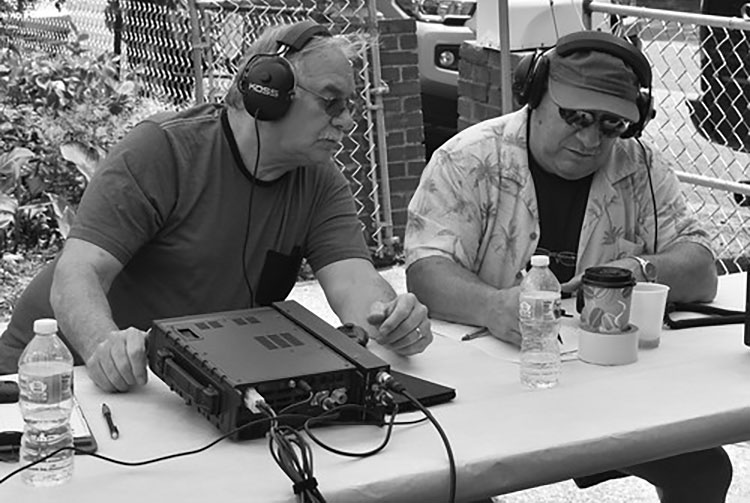
It was after reading Rawles’ Patriots series that I set out to start my own ham radio tutorial. That book, while fiction, showed me the value of ham radio in a post-disaster environment. It wasn’t long afterwards that I began to look into getting licensed as a ham myself and started to invest time and (and a bit of money) in ham radio. I believe that is the proper way to look at ham radio – as an investment. Post-disaster, particularly post-massive disaster (e.g., EMP, terrorist attack, war, largescale power outage, etc.) there truly is no better means for long-distance communications than a ham radio.
As such, I highly recommend that preppers look into doing what they can to get involved in ham radio now before it is too late. The challenge, however, comes when the intricacies of ham first begin to surface. I’m by no means an engineer. College physics just about destroyed my GPA. As a result, when I first started studying up on amateur radio it felt as if I was never going to understand anything about it. Several times I almost gave up out of frustration.
Thankfully, I stuck with it, and I’ve learned enough to be able to share that information in as helpful a manner as possible. For those who are looking to get involved in ham radio – maybe even just bought your first UV-5R and are wondering what in the world to do next – hopefully you’ll find the following guide of some service.
Do I Need a Ham Radio License?
You can listen to all legal frequencies on a ham radio, but you need a license to transmit across any ham frequency. So, yes, if you are wanting to transmit across ham frequencies you are going to need a license.
There are three different licenses that you can get: the Technician, General, and Extra. The Technician license is the easiest to get, and it’s what I recommend starting off with. The Technician gives you the least number of “privileges” and frequencies to use, but it’s still well worth your time, particularly if you’re not engineer-minded like myself. The Extra gives you the entire range of legal frequencies for a ham to transmit from, and the General falls somewhere in between.
If you’re looking at transmitting incredibly long distances (across states or countries), then you’re going to want to look at getting your General or Extra license as the Technician license doesn’t really give you much legal room here.
Types of Stations
When you hear people refer to their “station” it means the radio rig they’ve set up. There are four main types of stations: HT, base, portable, and mobile. All four of them have intrinsic value for the prepper, and you may want to look at investing in each format.
Handy-Talky
HT stands for “handy-talky” and is basically just a radio that you can carry around in your hand. These are typically the cheapest radios that you can buy, and the range of them is going to be the worst out of all four station types. They are convenient however, and can easily fit into a bug out backpack for unexpected SHTF situations. It’s this convenience -this ability to just slip into a Farady phone bag for when they’re ready to use – that makes a HT likely to be the radio that you have closest to you when disaster strikes.
Base Station
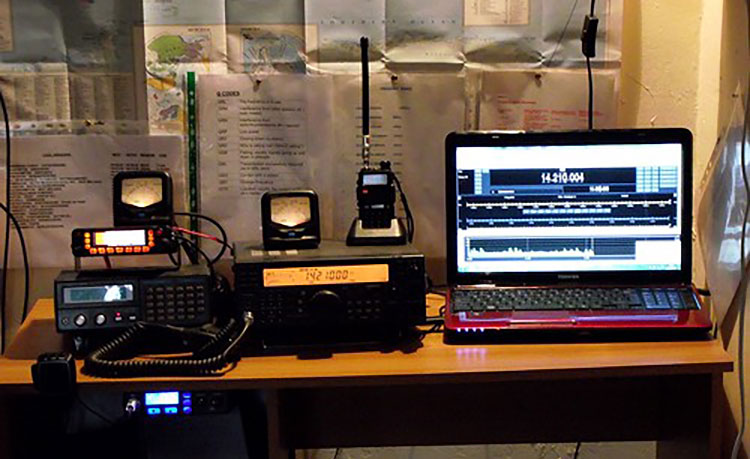
A base station is a more elaborate at-home rig. It often has several large components attached to a large outside antenna. The best long-range contacts typically come from a base station. You can easily spend some serious money on a base station, but you can also do some amazing things from one (which we’ll look at).
Portable
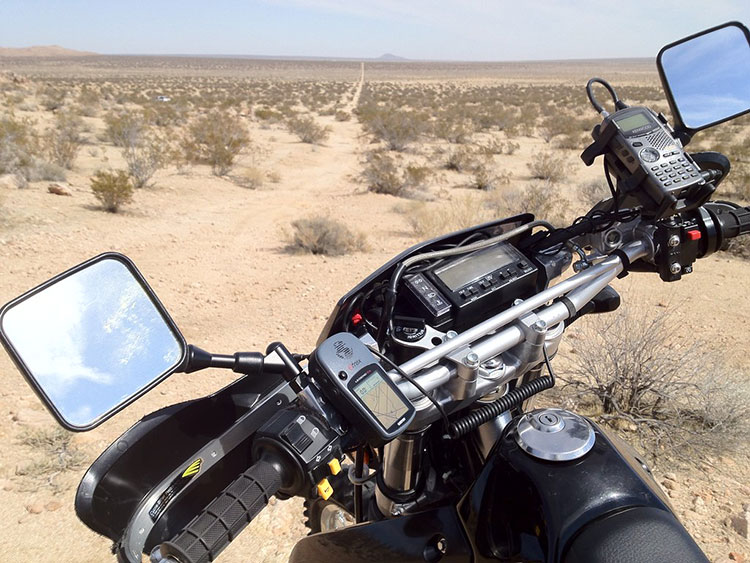
photo credit: KN6KS Palmdale – Barstow Road via photopin (license)
Portable radios are the coolest of the lot if you ask me. They’re akin to what an Army sniper team would carry around with them. These enable you to make significant range communications while out in the bush somewhere. They also allow you to engage in the Summits on the Air contest (SOTA). It’s a great way to practice your ham survival skills while exploring the trails near your home.
Mobile
A mobile station is just a radio that you install in your vehicle. Most of them look very similar to the CB radios that you’ll see hunters have installed on their trucks. I like these because if disaster strikes while you’re on the road (e.g., civil unrest), you easily have a means of communication at hand perchance you don’t have your phone, your phone’s dead, or there’s no cell service.
FCC Rules
The FCC, or Federal Communications Commission, is incredibly particular when it comes to ham radio’s rules, and if you break them you could very easily end up facing a hefty fine. From what I understand, this isn’t so much from the FCC actively monitoring all radio stations (though they do), but instead from retired old men who sit around trying to capture “illegal” transmissions so that they can report people to authorities. Ask around. You’ll hear the same.
The first thing you need to know is that there are power limits on different transmissions. Normally, transmissions will be set for a specific power output. Some people may want to increase the range of their transmission by increasing their power output. When they do this beyond the legal limits, they can end up in big trouble.
There’s also no cussing allowed according to the FCC, nor any obscene language. If you’re going to transmit, it’s best to avoid saying anything that could be construed as obscene unless you want to be reported to the FCC.
The FCC also doesn’t allow any form of encryption or coded messages of any kind. The only reason I can think of the FCC doing this is so that businesses don’t end up taking over all of the ham bands with encrypted messages to other offices of theirs. The stinky thing about this is that with ham radio you cannot expect any privacy. Think of it like a party phone line from the 50s on landlines (read why you need a landline), where the entire neighborhood could listen in on your conversations. It’s the same deal with ham.
Anybody can tune to the frequency you are transmitting over and listen to what you’re saying. Though there are a heck of a lot of radio frequencies to transmit on, anybody with a spectrum analyzer could easily determine which frequency is being used, and then turn to that one to listen in. There are workarounds to increase your radio privacy, but for the most part just know that you’re likely being listened to by others.
Morse Code
When you hear somebody referring to CW, just know that they mean Morse code. CW is just the abbreviated form of “continuous wave,” how Morse code is transmitted. There are a few advantages to learning Morse code, such as the ability to transmit a message a further distance with minimal power. Learn more about Morse code.
Radio Bands
There are three different sections of radio frequencies that are arranged as “bands”: very high frequency (VHF), ultra-high frequency (UHF), and high frequency (HF). Each of these bands has different purposes that you should be aware of, and each of them (or rather sections of each of them) require various ham licenses.
Typically, both VHF and UHF are used for close range communications. Within a direct line of sight VHF/UHF work great. Even within your city, county, or state both VHF/UHF work great, it’s just that since we’re now talking about a distance greater than two miles, your radio is going to have to utilize something called a “repeater” to get your signal to the intended recipient.
Repeaters
Think of a repeater as the internet age version of the Pony Express. Provided that you have your radio programmed to access a particular repeater (a seasoned ham – typically an old engineer – can help you do this for your radio), your message will reach a big, specialized antenna which will then take your signal and carry it even further. Whereas you may be able to only reach a friend two miles away with line-of-sight communications, with a repeater you can easily reach a friend 10 miles away or more. Perhaps even across your state. Repeaters help carry your signal further. Emeline describes it further in her Tricked Out Overlanding Communication Systems article.
High Frequency Radios
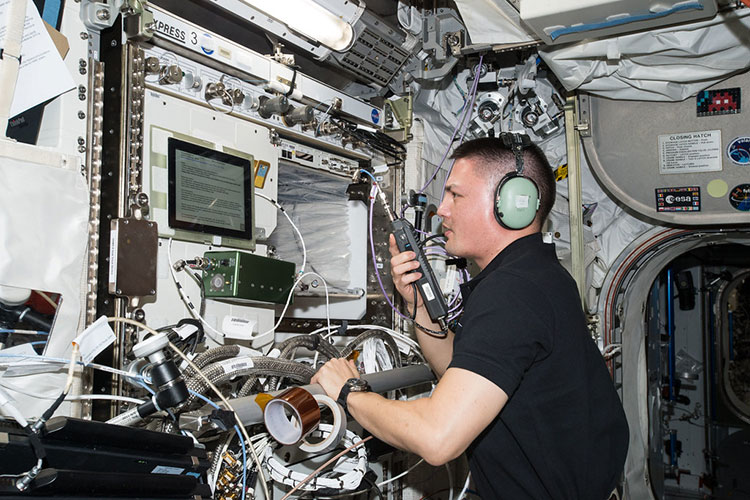
Let’s say there are no repeaters within your region though. This could be because none were ever built in your region or something such as a tornado or EMP took all the nearby ones out. If such were the case, you could use an HF radio to make a direct contact with your friend on the other side of the state without having to worry about there not being any nearby repeaters.
Let’s say that you lived in the frigid, harsh, and merciless northern climate of Maine and wanted to contact your friend in the lovely, sunny, and cheerful state of Georgia. For nationwide crossings, once more HF reigns supreme. This makes it a perfect radio band to be able to access perchance you have family scattered throughout the states and you want to be able to contact everybody if there’s no longer any cell service or a disaster of some kind has just struck.
Furthermore, HF is perfect for international connections as well. If perchance you were on a trip to Ireland when some type of EMP event took place, and the rest of your family was in Texas, not only would you be the only person with a cowboy hat in that entire country, but you’d also still be able to talk with your family to let them know that you were okay – provided that you both had protected HF radio equipment.
International Connections with VHF/UHF
You can engage in international connections with VHF/UHF as well, but only through an internet connected radio.1 The chief example of this would be to have Echolink on your smartphone. Echolink is an app only available to licensed hams which enables you to use your phone’s internet connection to talk with other hams around the globe. It’s a nifty app that I recommend downloading if for no other reason than that it serves as a backup form of communication.
A Bit More Depth on Very High Frequencies (VHF)
The VHF band operates from 30 – 300MHz and works great in regions where you’re not near skyscrapers and other buildings. Man-made structures act as something of an impenetrable wall to VHF frequencies. They can’t penetrate them.
Of the VHF band, there are three wavelengths that hams can utilize: 6 meters, 2 meters, and 1.25 meters. The one that you’ll most likely see being used is the 2-meter band. Pretty much every handheld radio that you see out there operates from the 2-meter band (as well as perhaps another).
A Bit More Depth on Ultra-High Frequencies (UHF)
Like VHF, ultra-high frequencies work great for line-of-sight communications. Unlike VHF, ultra-high frequencies actually perform very well in cities, towns, and other areas where there are a lot of man-made structures. This is because the smaller wavelengths of UHF make it so they can slip right on past reinforced concrete and other building materials.
UHF operates from 300-3000MHz, and the two bands you’ll see are 70 centimeters and 65 centimeters. What’s important to know though is that the 65-centimeter band is not a ham band, meaning that if you access it without the proper licensing, you could get in trouble. It is for the use of those with a GMRS license. These are easily obtainable for around $80 or so, and do not require a test to get the license.
A Bit More Depth on High Frequencies (HF)
HF is commonly also referred to as shortwave. HF operates from 3 – 30MHz and has ten bands that a properly licensed ham can use: 80 meters, 60 meters, 40 meters, 30 meters, 20 meters, 17 meters, 15 meters, 12 meters, 11 meters, and 10 meters.
HF can operate off two distinct methods of transmission: groundwave and skywave. A groundwave HF transmission will follow the contour of the earth until it reaches its intended recipient. Well, technically, the transmission won’t stop at the intended recipient – it’ll travel as far as it can – but you get the point.
A skywave HF transmission is like using a flashlight in a room full of mirrors. With skywave, your signal will go up to the ionosphere where it will then bounce back down to the ground where another station will be able to hear what you have to say.
What is Squelch?
If you’ve read around on enough different ham forums, you’ll undoubtedly have heard the term “squelch.” Every radio out there will have a means to prevent the owner from having to listen to a bunch of fuzzy background nonsense so that you can really zero in on the transmission that you want to hear. This ability comes from a squelch control knob. There are many different types of squelch controls for radios – which are a bit beyond the scope of this piece – but just know that squelch makes it so that you can listen to what you want to listen to – an incoming message.
The Antenna
The antenna is the most important piece of hardware that you will buy for your radio. If you have a lousy antenna, both your transmissions and the messages that you receive are going to be crappy as well. This is really a part of your station that I wouldn’t skimp on money-wise. You get what you pay for here.
Directional and Omnidirectional Antennas
The main two types of antennas are directional antennas and omnidirectional antennas. A directional antenna must be pointed towards its intended recipient. Advantages of this are that you’re able to transmit and receive messages a further distance because things are more “focused.” You also have a greater degree of privacy for your communications as well since your transmissions won’t be broadcast in 360 degrees around you. They’ll be broadcast one way – the direction that you’re pointing.
An omnidirectional antenna sends and receives messages from 360 degrees. This is great if you don’t particularly know what direction the person is that you want to reach. It’s also great for being able to take in as much information from all around you as possible. Disadvantages are that you’re not able to send or receive messages from as far away as a directional antenna.
Antenna Gain
“Gain” is a metric used to determine the effectiveness of an antenna. The higher the gain, the better the antenna. It acts as something of a funnel. A higher gain concentrates your signal better than a lower gain does. It’s measured in dB, and for every 3dB of gain, your signal’s strength doubles.1
Types of Antenna Mounts
If your first radio is a handheld model, it most likely comes with a little small antenna. This is referred to as a “rubber duck.” They suck. Update your antenna as soon as possible if you just bought a handy-talky. My stock UV-5R antenna barely let me transmit a message anywhere. When I bought a longer “whip” antenna (basically just a long flexible antenna), my radio’s abilities improved dramatically.

If you’re looking at installing a mobile radio in your vehicle, you have three options: a magnetic mount, a window mount, or a hardware installation. Out of the three of these, I recommend going ahead and drilling a mount onto your vehicle so that the antenna will be firmly attached. If you don’t know how to do this, there’s most likely an electronics store in your area that will gladly do so for around $30 – $100.
The reason I recommend this is because it’s the most stable of the mobile antennas. A magnetic mount can easily end up scratching the roof of your car, and when the base of the mag mount begins to rust, it won’t be long before the roof of your car begins to rust as well.
Window mounts don’t work with all types of auto glass, I like the ability to roll down my windows, and I don’t like the way window mounts look.
Feed Lines
Unless you’re operating a HT, you have to have a feed line for your antenna. A feed line is basically just a cord that attaches your antenna to your radio. Do not turn on your radio if there is no antenna attached. You’ll end up frying the insides of your radio. If you just bought a $1000 HF radio, this can be an incredibly expensive lesson to learn. Like your antenna, you should buy as nice of a quality of feed line as you can afford. It truly plays a drastic role in the quality of your outgoing and incoming messages.
The most common type of feed line is referred to as “coaxial cable.” There are different types of coax, but the most popular are RG-58, RG-8X, and RG-213:
- RG-58 – Only used for HF when you need 50’ or less of cable to connect your radio to your antenna. This is because of its higher losses. It should never be placed at the output of an amplifier either.
- RG-8X – This will carry full legal power for an HF radio, but you don’t want to use it when you need more than 100’ of cable to connect your radio to your antenna. You also don’t want to use it for mistuned antennas. For VHF/UHF radios, this type of coax can be used up to 50’ for 2 meters, and at distances less than 25’ for 70cm.
- RG-213 – This is great for all HF uses unless you need an extremely long length of coax to attach your radio to your antenna. For a VHF/UHF radio, this makes a good coax if the distance is less than 50’.1
Sending Images
This isn’t covered in any other ham radio crash course, but you can actually use a ham radio to transmit and receive images. If this is something that is of interest to you, you need to make sure that the radio you are looking at buying has the capability to do so. There are several different ham image modes available. They are:
- Amateur television (ATV) – This lets hams transmit and receive quality video and audio. It’s commonly referred to as HAM TV, or fast-scan TV (FSTV).
- Slow scan television (SSTV) – You can transmit quality photographs in color or black/white with SSTV. If you were in a WROL type environment, and you had patrols reporting on an invading force, SSTV could be used to transmit images of force size, vehicle types, and so on.
- FAX480 – This lets you send fax messages with a higher quality than SSTV. Fax480 has a resolution of 480 lines, whereas SSTV has a resolution of 240 lines.
- Weather Facsimile (WEFAX) – This utilizes satellites to transmit weather images. If you’re in a post-disaster environment, you quickly discover how important it is to be able to predict the weather. WEFAX capabilities would help you to be able to do so.2
Ham Radio Tutorial Further Reading
If you’re looking at more information on ham radio, I highly recommend checking out the following. They’ve helped me out a lot through the past.
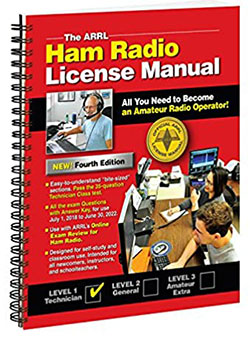
The Ham Radio License Manual from ARRL is the book that any ham radio operator has on his/her bookshelf. If there was a book devoted to being a ham radio crash course this would be it. Use it to study for your exam and you will also find yourself referencing it for years go come. Well worth the money!
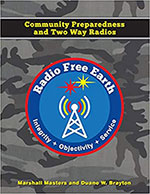
In the same vein, Radio Free Earth by Marshall Masters is easily the best book out there I’ve found to date on post-disaster radio communications. I personally think he’s a bit of a nut, but if you can weed through all of the rants, there’s a lot of great value in here that you won’t find a lot of other places.
Final Thoughts
If you know and understand the above, you’ll have something of a ham radio crash course. Keep in mind that ham radio is something that you could spend a lifetime studying though and still not know everything that there is to know about it (or so I’ve been told). If you understand the above however, you’ll be able to begin to get your feet on the ground and move forward with transmitting and receiving messages.
Are there other aspects of ham radio that you feel should have been included in this crash course? Do you have any experience with ham radio, or other suggestions for those who are just getting into it? If so, please let us know in the comments below!
- https://www.arrl.org/files/file/Ham%20Radio%20License%20Manual/HRLM%203rd%20ed/Choosing%20a%20Ham%20Radio-2014.pdf
- Radio Free Earth, pg. 70-71

14 comments
Great post. Very informative. One thing to be aware of though. The phrase “Ham Radio Crash Course” I believe is copyrighted. It’s a YouTube channel, podcast, Instagram and Facebook page. If you’re going to keep using that phrase for your own content you’ll probably come into some issues.
Just letting you know. He’s put a ton of time and energy into this brand.
Thanks. We’re just writing an article, not building a brand around the name. You can write an article with “Microsoft” in the title and not run into problems. Not trying to steal anyone’s trademark, market a product under that name, etc.
I worries. I wasn’t meaning to sound accusing. Just letting you guys know. I appreciate your post about ham radio. It’s not often an intro post is so accurate in its description of the topic. You guys nailed it with this one. Thanks for correctly explaining this hobby to your readers. It’s appreciated.
No, I understand, and it’s certainly not our intent to step on anyone’s toes. I don’t think we’re doing that, however. I appreciate the comment.
Nice little article. I wish I’d been able to read it last year when studying for my tech exam.
I just want to emphasize that folks can get into the hobby without a great investment of time or money.
With about eight hours of study, you can probably pass your exam. A hundred bucks will cover your exam fee, a decent handheld, and even the (optional) first-year dues for the local Ham club. I pay the club dues as a courtesy since I use the club’s repeaters.
I don’t plan to go much further with the hobby. I might get a good mobile unit installed. For me it’s more a matter of utility than a lifelong avocation. Being able to chat with locals during last week’s miniature Ice Age (I’m in Arkansas) was a big help in determining the status of roads, and checking on the well-being of friends of mine.
For those wanting to pass the test, I highly recommend a youtube video. KB9OKB is the channel name, as well as the instructor’s call sign. Introduction to ham radio and Technician Training Class is the video name. It’s one hour long.
I went into the course with Zero knowledge of Ham Radio or electronics.
Day one…watched it straight through without taking notes.
Day two…watched it, pausing to take notes and work out the problems on paper. Took about three hours.
Day three…I watched it straight through, took some practice exams at hamstudy.org, then drove to the local Ham club and passed my test.
It’s easy and cheap to enter the hobby.
Nice article. Preppers will find lots of like-minded folks among their local Ham community.
Thank you for the article. I’m interested in that little hand-held Beofeng radio with the whip antenna. In stooging around the internet a bit, it seems that these radios need to be programmed somehow with a computer. I like the idea of listening and being able to chuck it in a go bag, I’m not a programmer. Can you provide some guidance?
Hey Spooky.
Love the name, btw.
I’m not the expert on the subject, but I can help you out. Most of the Baofengs do not “need” to be programmed with a computer. You can still enter the freq, offest, tone, etc. manually. But most come with a computer cord that will let you program them. It makes it a whole lot easier.
As a newbie, I do recommend at least learning how to program manually. That way you can do it again if you need to. But after you’ve done a channels, plug it to the PC and load in all the stations you want.
I got the UV82 Baofeng. I added a folding tactical antenna, that’s all. Even with it, I can hit a repeater from about twenty miles away. Granted, that was on flat land.
And if I’ve said anything incorrect here, I welcome more experienced operators to chime in and correct me. As I said, I’m still learning and having fun.
Thanks Duke – I’ve got a learning curve coming my way. I’m stooging around some radio forums etc. to get some knowledge. And there’s a lot to learn, to say the least.
Regarding specific radios, I’ve also come across the AnyTone OBLTR-8R which appears to have a lot of desirable features. I’m in Central FL – it’s flat but fairly crowded.
I was surprised to see a photo I took online. Not that I care if you use it. Its a pic of Vince KC2WPP and Guy K2HOT of the Suffolk County Radio Club in NY at a field day about 2 years ago.
99% sure it came from a royalty free site or was otherwise marked as free to use under Creative Commons. I’ll take it down or give you credit if you’d like.
I glad you used it. ive never had a photo used before, and am honored that you found it suitable for the article.
Thank you.
I don’t care if you use ham radio crash course. I don’t care who thinks they copyrighted what. It would be near impossible to prosecute such a common phrase. Use it all ya want. I’m not watching or reading that other guy anyway. Just you.
Great way to socialize when the weather is a mess outside or just to cold to go out. It’s also a lesson in Physics that’s understandable. It takes time to sink in but ut will. So many different variations of modes to utilize and many Nets to listen and participate in. Start with the Tech license as it’s mostly about rules and it’s easy to get your foot in the door. Lastly, be kind to others and their differences when talking to others. It will go a long way to building a group of friends to stay in touch with around the world if you like.